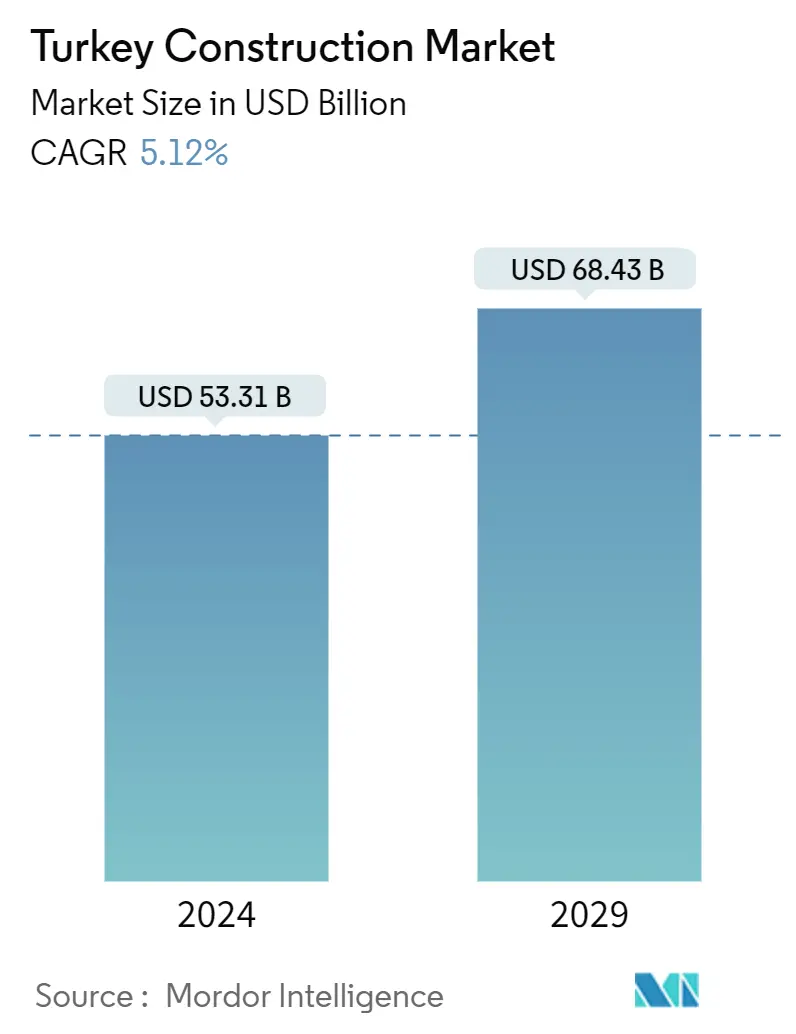Market Size of Turkey Construction Industry

| Study Period | 2019-2029 |
| Base Year For Estimation | 2023 |
| Forecast Data Period | 2024 - 2029 |
| Market Size (2024) | USD 53.31 Billion |
| Market Size (2029) | USD 68.43 Billion |
| CAGR (2024 - 2029) | 5.12 % |
Major Players
*Disclaimer: Major Players sorted in no particular order |
Turkey Construction Market Analysis
The Turkey Construction Market size is estimated at USD 53.31 billion in 2024, and is expected to reach USD 68.43 billion by 2029, growing at a CAGR of 5.12% during the forecast period (2024-2029).
- Due to the COVID-19 pandemic, the construction industry has taken significant hits in Turkey, with construction site closures, project cancellations, supply chain disruptions, and cash stagnation. Because the construction sector is interconnected with over 200 subsectors, any disruption in one of them is expected to cause a ripple effect in the construction sector.
- Construction is an especially important part of the Turkish economy, as it is in many other developing countries. As a result, disruptions in the aforementioned sector have had a greater negative overall impact than they would have in a less dependent, more developed economy.
- By 2023, the Turkish government plans to construct 2,000 kilometers of high-speed rail lines from Kars in northeast Turkey to Edirne in western Turkey, with China funding a portion of the project.
- The government also wants to increase renewable energy's share of electricity generation to 38.8% by 2023, up from 32.5% in 2018. The residential sector is expected to grow significantly over the forecast period because of the government's new urban development program and the country's interest rates being lowered.
- Turkey’s nationwide house prices rose by a whopping 189.9% in November 2022 from a year earlier, to an average of TRY 16,984 (USD 904) per square meter (sq. m.), according to the Central Bank of the Republic of Turkey (CBRT), following y-o-y rises of 64% in 2021, 32.6% in 2020, and 2.9% in 2019.
Turkey Construction Industry Segmentation
The construction market includes a wide range of activities that cover upcoming, ongoing, and growing construction projects in different sectors, which include but are not limited to geotechnical (underground structures) and superstructures in residential, commercial, and industrial structures as well as infrastructure construction (like roads, railways, and airports) and power generation (transmission-related infrastructure). Construction is an industry that includes the erection, maintenance, and repair of buildings and other immobile structures and the building of roads and service facilities that become integral parts of structures and are essential to their use.
This report covers market insights, such as market dynamics, drivers, restraints, opportunities, technological innovation and its impact, Porter's five forces analysis, and the impact of the COVID-19 pandemic on the market. In addition, the report also provides company profiles to understand the competitive landscape of the market.
The Turkish construction market is segmented by sector (residential, commercial, industrial, infrastructure (transportation), and energy and utilities). The report offers market size and forecasts for the Turkish construction market in value (USD) for all the above segments.
| By Sector | |
| Residential | |
| Commercial | |
| Industrial | |
| Infrastructure (Transportation) | |
| Energy and Utilities |
Turkey Construction Market Size Summary
The construction industry in Turkey is poised for growth over the forecast period, driven by various infrastructure and urban development projects. Despite the setbacks caused by the COVID-19 pandemic, which led to site closures and supply chain disruptions, the sector is expected to recover and expand. The Turkish government's initiatives, such as the construction of high-speed rail lines and the expansion of Antalya International Airport, are set to play a significant role in this growth. Additionally, the focus on increasing renewable energy capacity aligns with the country's environmental goals, further supporting the construction market's expansion. The residential sector is anticipated to experience substantial growth due to government urban development programs and favorable economic conditions, including lowered interest rates.
Turkey's construction market is characterized by a competitive landscape with several key players, including Renaissance, Alarko, and TAV Construction. The market's moderate concentration indicates a healthy level of competition among these companies. The rise in residential mortgage loans and the increasing demand for modern residential apartments, both from domestic and foreign buyers, are contributing to the market's expansion. The government's strategic plans, such as relocating military sites and redeveloping areas in Istanbul, are expected to create additional opportunities for construction activities. As Turkey continues to develop its infrastructure and urban areas, the construction market is likely to see sustained growth, supported by both public and private sector investments.
Turkey Construction Market Size - Table of Contents
-
1. MARKET DYNAMICS AND INSIGHTS
-
1.1 Market Overview
-
1.2 Market Dynamics
-
1.2.1 Drivers
-
1.2.1.1 Increasing manufacturing sites
-
1.2.1.2 The increasing middle-income group and access to mortgage finance
-
-
1.2.2 Restraints
-
1.2.2.1 Rising cost of construction materials.
-
-
1.2.3 Opportunities
-
1.2.3.1 Increasing focus on building earthquake-resilient buildings.
-
-
-
1.3 Value Chain/Supply Chain Analysis
-
1.4 Industry Attractiveness - Porter's Five Forces Analysis
-
1.4.1 Bargaining Power of Suppliers
-
1.4.2 Bargaining Power of Consumers/Buyers
-
1.4.3 Threat of New Entrants
-
1.4.4 Threat of Substitute Products
-
1.4.5 Intensity of Competitive Rivalry
-
-
1.5 Technological Innovations in the Construction Sector
-
1.6 Insights into Costs related to Construction and Building Materials
-
1.7 Government Regulations and Initiatives by the Industry
-
1.8 Spotlight on Prefabricated Buildings Market in Turkey
-
1.9 Brief on Real Estate Market and Key Real Estate Players
-
1.10 Insights into Services Allied to Construction (Design and Engineering, Fit-out Services, Facility Management, etc.)
-
1.11 Insights into Key Distributors/Traders of Construction Materials
-
1.12 Impact of COVID-19 on the Market
-
-
2. MARKET SEGMENTATION
-
2.1 By Sector
-
2.1.1 Residential
-
2.1.2 Commercial
-
2.1.3 Industrial
-
2.1.4 Infrastructure (Transportation)
-
2.1.5 Energy and Utilities
-
-
Turkey Construction Market Size FAQs
How big is the Turkey Construction Market?
The Turkey Construction Market size is expected to reach USD 53.31 billion in 2024 and grow at a CAGR of 5.12% to reach USD 68.43 billion by 2029.
What is the current Turkey Construction Market size?
In 2024, the Turkey Construction Market size is expected to reach USD 53.31 billion.

